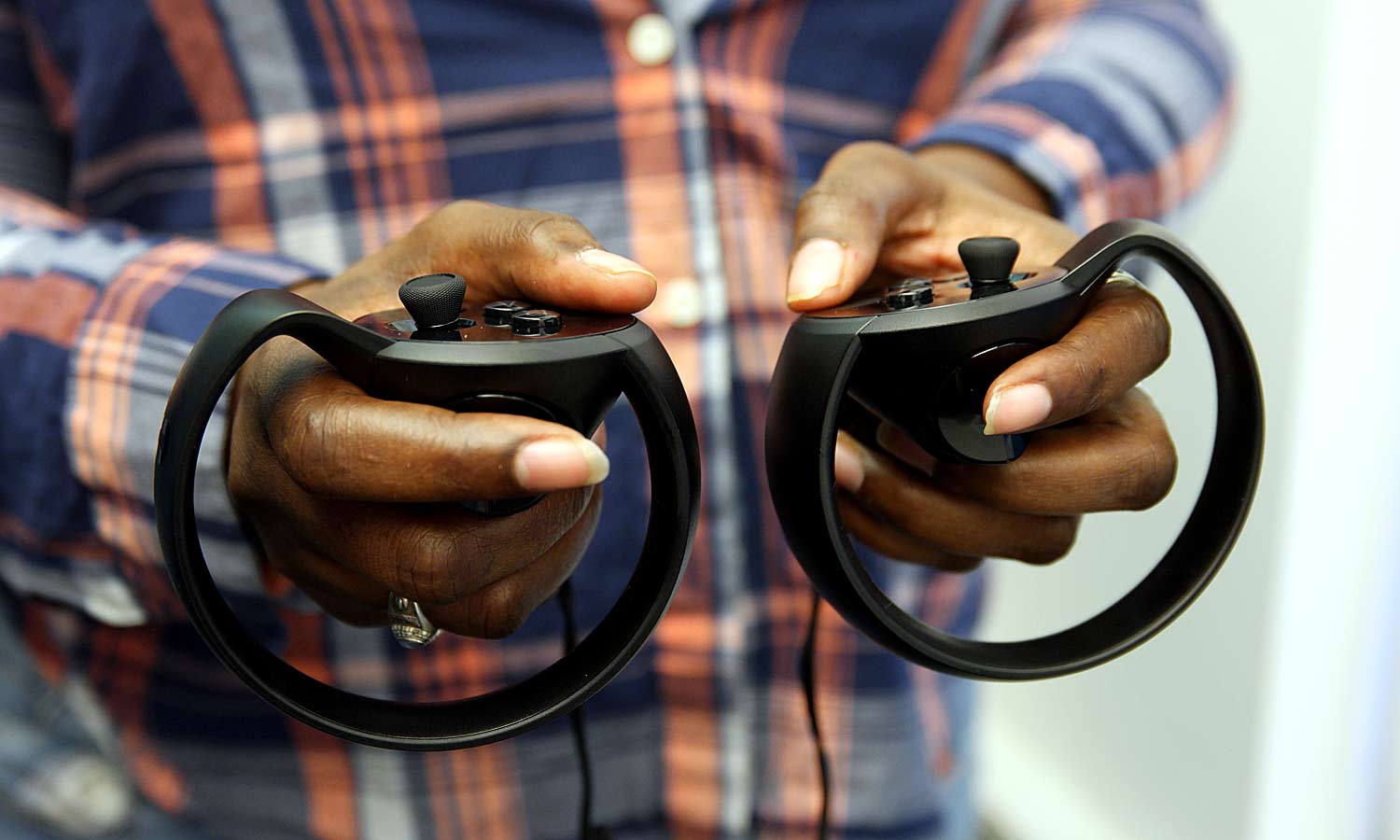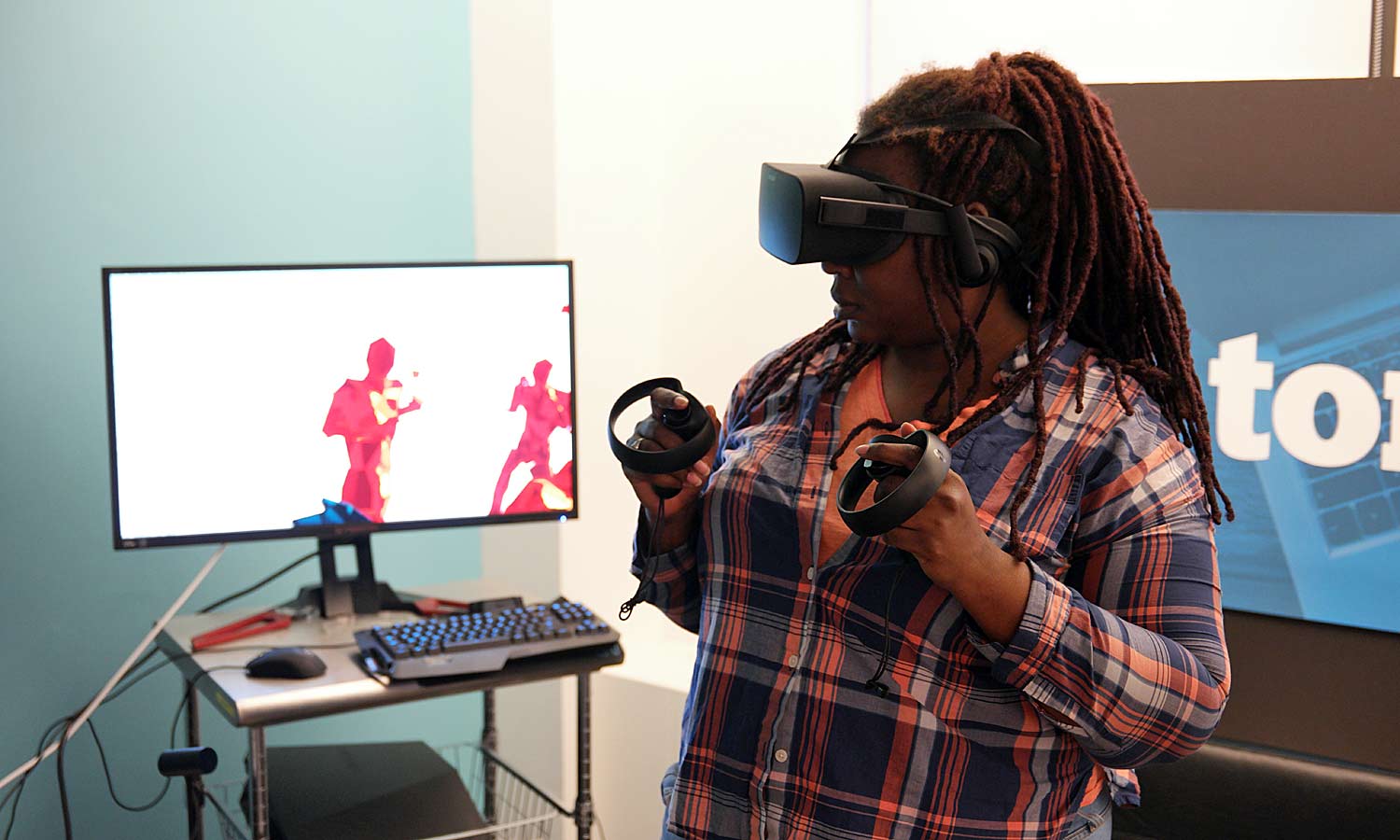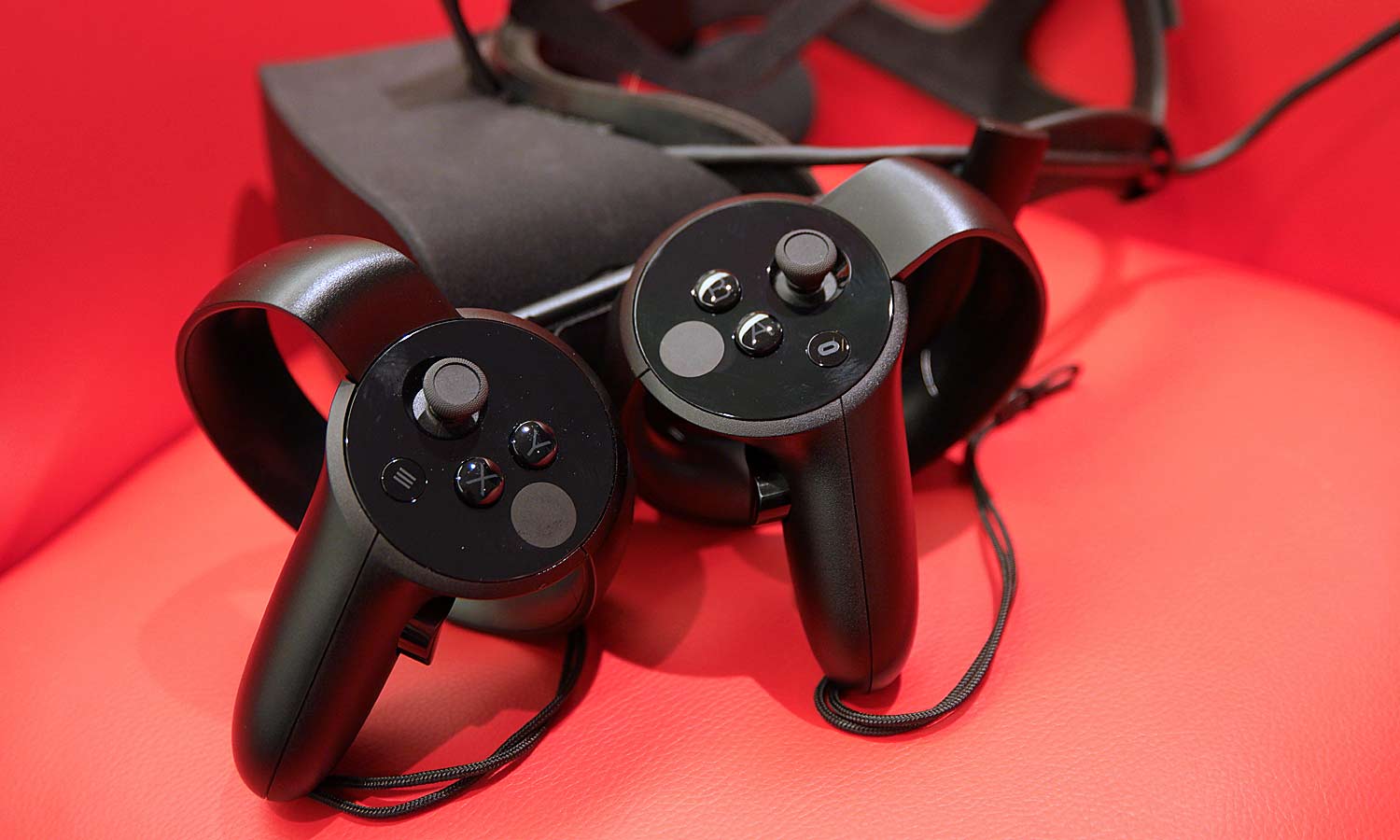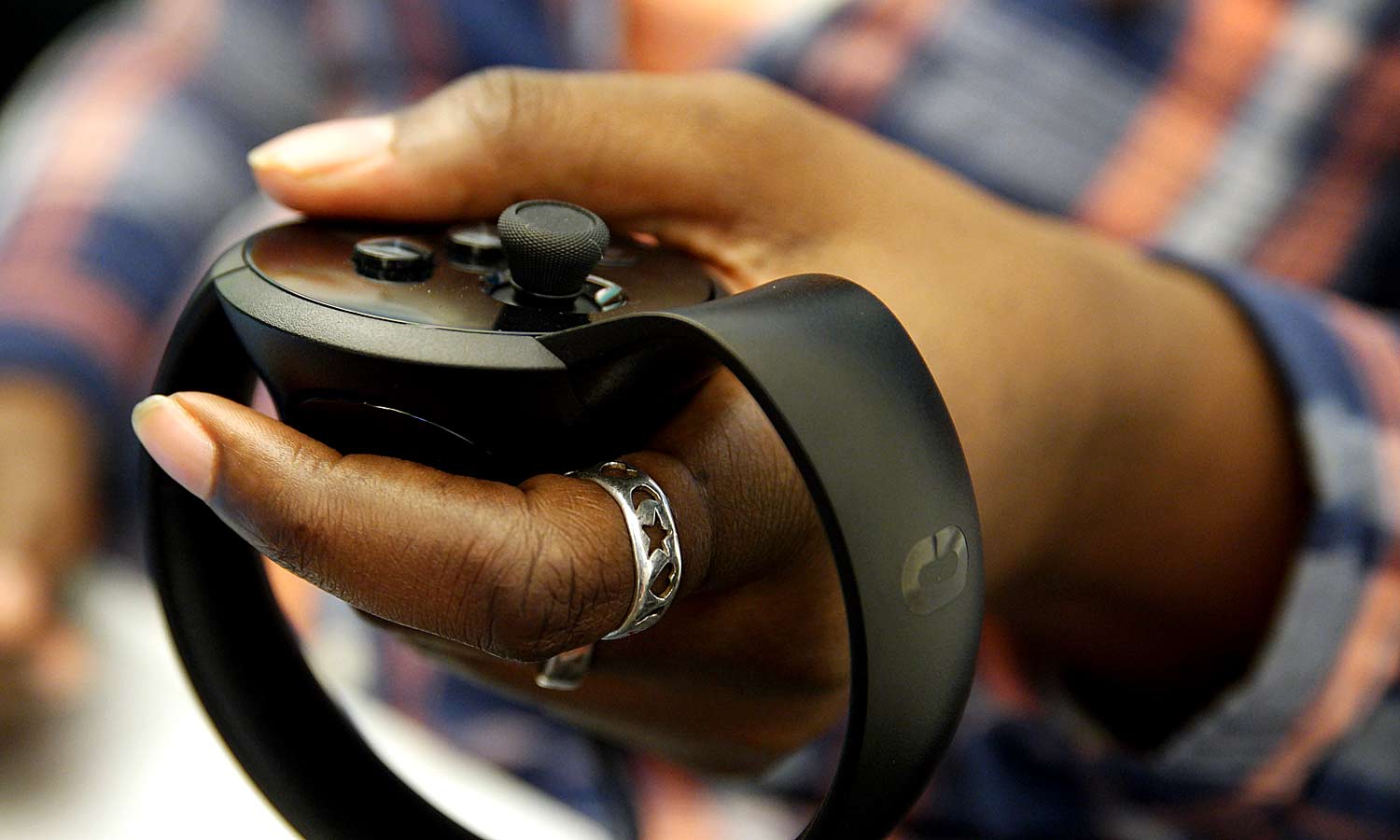Tom's Guide Verdict
The Oculus Touch Controllers are lightweight, easy to use and offer a deeply immersive VR experience
Pros
- +
Elegant, lightweight design
- +
Large library of compatible games
- +
Easy to use
Cons
- -
Small play area
- -
No room scale like HTC Vive
Why you can trust Tom's Guide
Oculus' new $199 Touch controllers are an elegant solution to a virtual reality problem I didn't knew I had — believable virtual hands. Sure, I've grabbed a gun or some other object in VR plenty of times, but I've never had the ability to extend a finger for a butterfly to land on or enough dexterity to perform surgery. Now I do. The long-awaited Touch controllers are light, easy to use, hella fun and add a new level of immersion to the VR experience. I wanted to touch everything and you will too — if you can get past a frustrating setup process with a second Oculus sensor.

In addition to rolling out more than 50 games for the peripheral, Oculus has also been busy at work building out the social aspects of the system. They've gone so far as to create a virtual avatar system. If you've been looking for a reason to pick your Oculus Rift back up or thinking about taking the VR leap -- now is the time. As welcome an addition as the Touch controllers are to Oculus, though, the HTC Vive remains the gold standard if you're looking for a walkable room scale experience.
Editor's Note: Oculus recently announced, upcoming Oculus Quest, the company's first high-end standalone headset. The new device will ship with hand controllers that will also be compatible with the Rift. For more news click here.
Design
Make no mistake, Oculus knows how to make a sleek-looking product. Constructed from a mix of matte and glossy black plastics, the Touch controllers are all curves and rounded edges — they're practically Apple-esque. The rear and side triggers are done in a glossy finish as are the faceplates at the top of the controllers and the small O adorning the curved matte arm wrapped along the sides and bottom of the devices.

Unlike the HTC Vive controllers, the Rift peripherals aren't ambidextrous. Both devices sport a single analog stick with a pair of face buttons and a handy thumb rest. However, the left-hand controller is home to the Y, X and Menu buttons while the right controller has the A, B and Oculus button, which takes you to the Universal Settings page.
MORE: Best VR Headsets
Included with the two controllers is another Oculus sensor to use with the original one that came with the sensor, a pair of AA batteries and a circular connector for Rock Band.
Get instant access to breaking news, the hottest reviews, great deals and helpful tips.
Setup
When I initially went about setting up the Rift and the Touch Controllers, everything was easy peasy, lemon squeezy. Following the picture and video prompts, I just had to plug in the headset and sensors, enter my height, calibrate the controllers and I was good to go. The second time around was fraught with frustration, due to a hinky positional tracking page. I wanted to be fancy and set up the room tracking feature, which Oculus says is still experimental.

As the name suggests, Oculus is toying around with bringing room-scaling technology in an attempt to match the HTC Vive. Ideally, the function would work with three sensors, but can theoretically work with two positioned in opposite corners of the room. If you're going to try for room scale, you'll need a space of a 4.9 x 4.9 feet for two sensors and 8.2 x 8.2 for a three-sensor setup. The HTC Vive, by comparison, requires 6 feet x 6 inches x 5 feet of space.
Folks, I tried everything short of standing on my head to get my two sensors into a position where both could clearly see the Touch controller as directed by the screen. Alas, it never happened, even after 45 minutes. Eventually, I pressed the Skip button, and settled for the tradition two-sensor front-facing setup that requires 6.5 x 6.5 feet of space. Despite being warned that the sensors might not track the controllers, I pushed forward.
Once I got over all the buttons and triggers, it felt pretty darned natural -- especially compared to the Vive's peripherals.
From there, I stood in the circle the sensors determined was the center of my play area, pulled the rear trigger on the controllers and voila! I was transported into a tutorial.
Populated by a cute robot and a digital hologram printer, I found myself in a bunker where I learned to navigate the triggers of the controller. I engaged in a series of whimsical activities, including pointing my index finger to allow a digital butterfly to land, squeezing a couple of digital stress balls and firing off a few toy rockets by holding the combustible in one hand and pulling the drawstring in the other.
At the end of the tutorial, I was transported to Oculus Home, which still appears as a swanky home with brick walls and floating tiles displaying your apps and games.
Touch vs. Vive: Reach Out and Touch Everything
So what's it like using Oculus Touch? Once I got over all the buttons and triggers, it felt pretty darned natural — especially compared to the Vive's peripherals. For starters, the Touch controllers are much lighter than Vive's controllers — to the tune of 5.7 ounces versus 7.3 ounces.
The Vive controllers aren't as immersive. The Touch provided a more realistic grabbing sensation, and it wasn't much of a leap to reach out and interact with something in the game.
While I definitely appreciate the versatility of the Vive's circular touchpad controllers, I'm not as big a fan of the side-mounted buttons. I find them hard to press and shallow to boot, especially when developers assign them as the lone means of grabbing something. I much prefer a trigger-based grabbing system, especially in shooters.
For me, the Touch controllers also provided a more realistic grabbing sensation due to the positioning of my hands on the devices. It wasn't much of a leap to make a fist or reach out and interact with something in the game as a result. The longer, more unwieldy Vive controllers aren't as immersive.
Games and Apps
Oculus owner Facebook wasn't afraid to put its money where its mouth is earlier this year, pledging $250 million for new games and apps. That pledge worked out pretty well for Oculus Touch, as the peripherals are launching with more than 50 titles, including indie darling Superhot, Insomniac Games' The Unspoken and Robo Recall, the spiritual successor to Epic Games' impressive Bullet Train VR demo.
The Touch controllers added another much-needed layer of immersion. Grabbing hold of a robot and ripping its head off is so much more visceral with a pair of hands than an Xbox controller. Titles like Surgeon Simulator offered more intricate control of my hands, mapping controls for my thumb and index fingers while grouping together the remaining digits. It gave me a bit more control than I normally have in a virtual title, which allowed me to carefully remove organs from patients -- well, more careful than usual.

So far, I've done my best Steph Curry imitation during the Three Point Shootout challenge in NBA 2KVR. I've launched mystical glowing knives at rival wizard fool enough to challenge me in The Unspoken. Once their guard was down, I unleashed a volley of magical cards to finish the duel. And I had a literal blast taking out wave after wave of hostile alien scum in Serious Sam VR: The Last Hope. That is until I caught a face full of viscous green alien goo and died. Throughout my varied experiences, the controllers firm buzzing provided the haptic feedback I needed to flesh out that gun recoil or banging on a magical anvil.
The Oculus library also has a few Touch-ready apps like Quill, the gorgeous painting app that in the hands of a professional can make all sorts of gorgeous 3D virtual paintings. If you're more of a sculptor, there's Medium.
MORE: Best Gear VR Games
As more developers get on the Oculus bandwagon, I'm looking forward to seeing even more non-gaming application including simulations for surgery, architecture and music. But for now, the library continues to be game heavy.
Leaning in to Room Scale
Where the Vive still has Rift beat is room scale. The edition of the second Oculus sensor definitely lets you move around a little bit more than the Rift by itself, but it's more of a lean with it, rock with it situation. That means that you won't actually be walking around in that 3 x 3-foot space allotted by the new improved Rift, more than arching your body in certain situations.

As demanding as the Rift is with its play space requirements, it allows you to literally walk around the room. Oculus is planning to unleash its take on true room scale, complete with its own boundary-tracking Guardian system in the near you'll just need another sensor and maybe some cord extenders.
But the ability to somewhat navigate the Rift's smaller play area means that you should be able to play games like Edge of Nowhere and Eve: Valkyrie without the nausea-inducing effects of simulation sickness.
Molded from Virtual Clay
Oculus (and Facebook) are serious about making virtual reality a more social experience — starting with your new avatar. Instead of the flat image profile I chose when the Rift debuted earlier this year, there’s now a clear human-like blob staring back at me when I look at my profile.
Grabbing hold of a robot and ripping its head off is so much more visceral with a pair of hands than an Xbox controller.
Clicking the profile button took me to a new feature where I could turn this transparent stranger into my new virtual avatar. There are several customization options, including avatar color, head, hair and wardrobe. The end result was a lilac-hued ghost with locs wearing a halter top, which doesn't look too bad in my honest opinion.
MORE: Best Gear VR Apps
Once I finished creating my virtual self, I launched Oculus Toybox, where I could play with toys with another Oculus-equipped person. Set in a child's room, I took turns catching and throwing a frisbee, playing ping pong and even built a castle with blocks. It's definitely a cute way to get some new virtual friends, but I prefer going head to head with people in the wizard-dueling The Unspoken or chucking discs Tron-style at foes in Ripcoil. Still it's cool having the ability to give a thumbs up or a high five when the occasion calls for it.
Bottom Line
Can you use your Oculus Rift without the Touch controllers? Well, of course you can, but I wouldn't recommend it. Setup hassle aside, the $199 Touch controllers bring the Rift one step closer to the Vive's game-changing room-scale technology. The peripherals are light and fairly intuitive and offer a level of hand and finger control that current VR titles are unable to match.
Thanks to Facebook's aggressive seeding efforts, Oculus continues to be the king of VR content. You'll be hard-pressed to find the wealth of entertainment, games and apps on another VR platform outside of the Samsung Gear VR.
However, Oculus' experimental room scale is just that — an experiment. Without longer cables to accommodate the sensor position requirements, most Touch owners will be unable to take a true walk in VR. For that, you'll have to turn to the $799 HTC Vive, which despite the massive play area, offers a level of immersion the Rift is still missing. However, if you're looking for an virtual reality experience that offers some of the best touch-enabled immersion on the market, the Oculus Rift and its Touch controllers are the devices to beat.

Sherri L. Smith has been cranking out product reviews for Laptopmag.com since 2011. In that time, she's reviewed more than her share of laptops, tablets, smartphones and everything in between. The resident gamer and audio junkie, Sherri was previously a managing editor for Black Web 2.0 and contributed to BET.Com and Popgadget.
